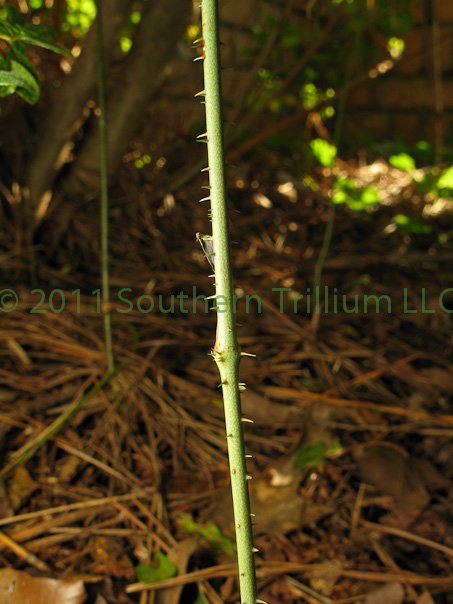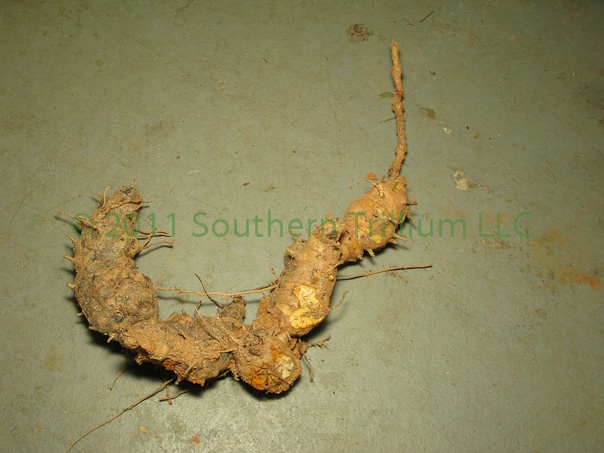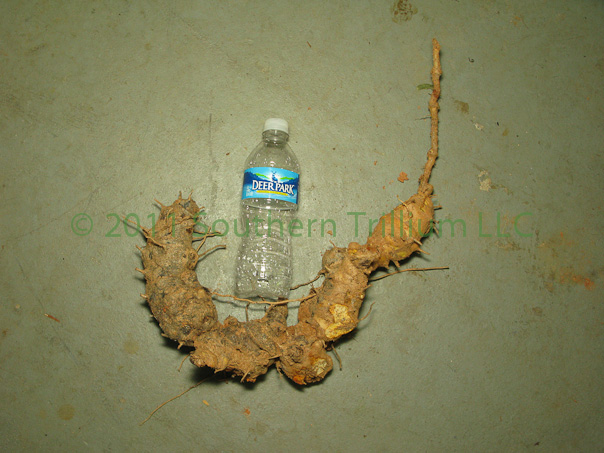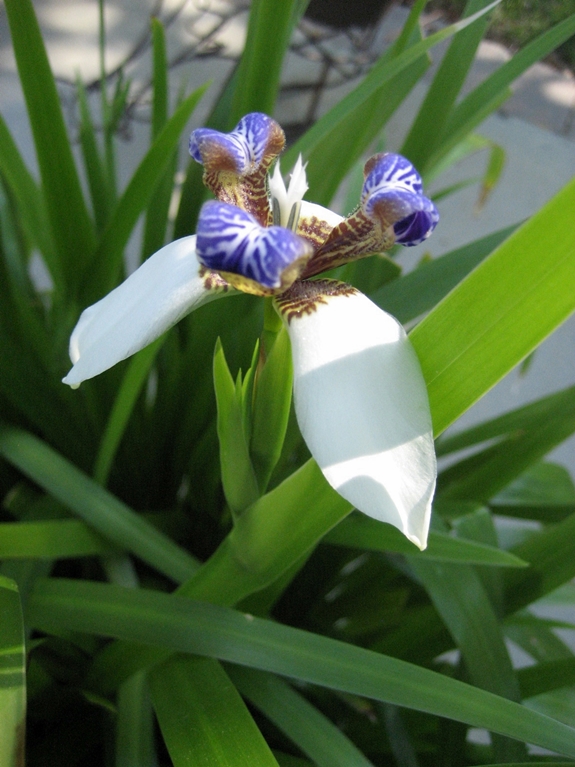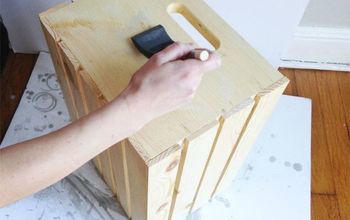How about a little Weed ID?

-
It is nasty stuff! I hate it when my fingers find it before my eyes do!
 Douglas Hunt
on Dec 02, 2011
Helpful Reply
Douglas Hunt
on Dec 02, 2011
Helpful Reply -
-
Looks like a smilax?
 Erica Glasener
on Dec 02, 2011
Helpful Reply
Erica Glasener
on Dec 02, 2011
Helpful Reply -
-
I agree with Erica, looks like smilax. Here is Walter Reeves on the subject: http://www.walterreeves.com/qa_display.phtml?qaID=2089
 360 Sod (Donna Dixson)
on Dec 02, 2011
Helpful Reply
360 Sod (Donna Dixson)
on Dec 02, 2011
Helpful Reply -
-
Erica is correct. I knew it was impossible to pull up, but a few years ago, I decided to dig one up just to photograph the roots/tubers.
 Southern Trillium LLC
on Dec 02, 2011
Helpful Reply
Southern Trillium LLC
on Dec 02, 2011
Helpful Reply -
-
I have a little smilax but far worse is the potato plant that is high on the list of Florida's most invasive plants. It is comparable to Kudzu in growth. The really bad thing is I bought this plant years ago and planted it in my yard. I'm still trying to kill it.
 Sherrie S
on Dec 02, 2011
Helpful Reply
Sherrie S
on Dec 02, 2011
Helpful Reply -
-
Hmmm, that explains why it keeps coming back. I've pulled these out of my azaleas and other shrubs only to see it winding its way through the following year. My doggies have also come trotting in with a hunk of this stuck to their fur.
 Teresa D
on Dec 02, 2011
Helpful Reply
Teresa D
on Dec 02, 2011
Helpful Reply -
-
Thorns underground! What is this plant thinking!
 Flowerscapes Garden Design & Landscaping
on Dec 02, 2011
Helpful Reply
Flowerscapes Garden Design & Landscaping
on Dec 02, 2011
Helpful Reply -
-
Believe it or not southern smilax adorns the entrances to many a home in "Old Raleigh" It's also very expensive if you can find it in the garden center around here. They can have all of mine.
 Mike and Anne
on Dec 02, 2011
Helpful Reply
Mike and Anne
on Dec 02, 2011
Helpful Reply -
-
It is called Cat's Briar, for obvious reasons. The young tendrils at the new growth area just below the leaves are edible and are listed in many wild edible plant books. Once established they are very difficult to get rid of and the berries that the produce are food for birds, who spread the seeds so that they can wind up anywhere at any time. http://www.google.com/imgres?q=Cats+briar&um=1&hl=en&sa=N&biw=1280&bih=878&tbm=isch&tbnid=LCjymhEXDobAIM:&imgrefurl=http://www.pbase.com/image/29256950&docid=kfb0IfJk_SNrkM&itg=1&imgurl=http://i.pbase.com/u45/comafungi/large/29256950.CatsBriar9802.jpg&w=800&h=600&ei=8jLZTtyZE8-Jtwe--ejuAQ&zoom=1&iact=hc&vpx=207&vpy=169&dur=376&hovh=184&hovw=248&tx=110&ty=68&sig=114045933214061786329&page=1&tbnh=157&tbnw=217&start=0&ndsp=20&ved=1t:429,r:0,s:0
 Paul M
on Dec 02, 2011
Helpful Reply
Paul M
on Dec 02, 2011
Helpful Reply -
-
A customer once called them 'the vine from hell'. CP
 Peace Painting Co., Inc.
on Dec 02, 2011
Helpful Reply
Peace Painting Co., Inc.
on Dec 02, 2011
Helpful Reply -
-
Smilax or greenbriar is also a popular food item for deer. They must be very careful munchers.
 Bob and RodMan S
on Dec 02, 2011
Helpful Reply
Bob and RodMan S
on Dec 02, 2011
Helpful Reply -
-
This is a green brier....Am told that the leaves are slightly bitter but can be eaten.
 Freeda H
on Dec 02, 2011
Helpful Reply
Freeda H
on Dec 02, 2011
Helpful Reply -
-
Nearly impossible to kill with Roundup, too. I am tackling a grove of this stuff along a fence line. It's been 3 years and I am almost there!
 Kim S
on Dec 03, 2011
Helpful Reply
Kim S
on Dec 03, 2011
Helpful Reply -
-
I can't remember name but know they are native to Georgia, have thorns and are prolific. I usually dig them up or mow over them as I see them. I take care they to not grow in my natural area because it is too small to accomodate them.
 Sonja
on Dec 03, 2011
Helpful Reply
Sonja
on Dec 03, 2011
Helpful Reply -
-
nasty stuff. we usually cut it to the base and paint a tiny amount of brush killer (concentrate-not dilluted) on each fresh cut. haha the foliage photo looks deceivingly like a clematis though...
 Anna K
on Dec 04, 2011
Helpful Reply
Anna K
on Dec 04, 2011
Helpful Reply -
-
There is a nearly thornless Smilax call the Jackson vine that is ornamental and decorative not a pest
 Erica Glasener
on Dec 04, 2011
Helpful Reply
Erica Glasener
on Dec 04, 2011
Helpful Reply -
-
That is what I have and cant get rid of It. it has taken over one corner of my yard!! I have been living here for 4 yrs and this is the worst it has been. It is a beautiful vine but it is in my rose bush and my orange tree.I have used round up and all kinds of strong weed killers and still cant get rid of it.It is smothering my rose bush.
 Carol G
on Jul 04, 2012
Helpful Reply
Carol G
on Jul 04, 2012
Helpful Reply -
-
I have some coming through the floor in my laundry room!! did not know they had a crack there.
 Carol G
on Jul 04, 2012
Helpful Reply
Carol G
on Jul 04, 2012
Helpful Reply -
-
I hate, hate, hate this weed! It comes through my fence. I spray it to no avail. I carefully pull them up or cut them with my shovel.
 Pamela F
on Jul 08, 2012
Helpful Reply
Pamela F
on Jul 08, 2012
Helpful Reply -
-
They are ugly, mean & nasty. The ONLY way I know to stop them is to dig them up. It is a lot work to get the root but well worth it. Roundup didn't do the job.
 Sherrie S
on Jul 08, 2012
Helpful Reply
Sherrie S
on Jul 08, 2012
Helpful Reply -
-
Smilax. all too familiar with this weed. Walter Reeves did a segment where his neighbor dug it up by the roots and it was over 18 feet long root system
 Jimmy S
on Jul 09, 2012
Helpful Reply
Jimmy S
on Jul 09, 2012
Helpful Reply -
-
As an "oldie but a goodie", we have always referred to this as 'Devils Claw' here in AL...Ouch! Those stickers will send you to the moon! I have some that have vines as big as small tree trunks and hundred feet high into my trees here on our homestead. I just leave most of them alone. They are great for the soil underground.
 Debbi C
on Jul 09, 2012
Helpful Reply
Debbi C
on Jul 09, 2012
Helpful Reply -
-
it is called saw brier here not good for lawn mower tires
 Joann Davis
on Aug 10, 2014
Helpful Reply
Joann Davis
on Aug 10, 2014
Helpful Reply -
-
the brown stuff looks like ginseng it is worth money
 Joann Davis
on Aug 10, 2014
Helpful Reply
Joann Davis
on Aug 10, 2014
Helpful Reply- See 1 previous
-
-
The thorns appear only on the first year or two. It is called buckthorn and is very invasive. They produce tiny black berries, which birds eat, roost and deposit everywhere. It looks almost like a tropical plant and climbs like ivy. The bare vines make neat wreaths because of its tendrils and won't reseed itself without the berries. We have programs to eradicate it in western Illinois parks and riverbanks as it crowds out the native plants, of which it isn't.
 Sally Roesner Fuhr
on Aug 10, 2014
Helpful Reply
Sally Roesner Fuhr
on Aug 10, 2014
Helpful Reply -
-
we always called it cardinal vine. don't ask me why, just always heard it called that. invasive and can make a mess of you, scratches all over. i am trying baking soda on this, creeping myrtle and bush honeysuckle and poison ivy this year. it changes the ph of the soil and is suspossed to stop anything.
 DORLIS
on Aug 21, 2014
Helpful Reply
DORLIS
on Aug 21, 2014
Helpful Reply -
-
Try Groundclear it is cheaper than roundup and suppose to last a year some vines will come back so spray again I talked to roundup and they said their stuff is only good for a month unless you buy the extended version (of course more money ) Groundclear clears everything
 Delores Snellen
on Aug 22, 2014
Helpful Reply
Delores Snellen
on Aug 22, 2014
Helpful Reply -
-
Spay Roundup on the leafy parts during growing season, spring and summer. It kills mine. Paint it on smaller plants if needed, just be sure it gets on the leaves.
 Rosannadanna
on Jan 24, 2015
Helpful Reply
Rosannadanna
on Jan 24, 2015
Helpful Reply -
-
Saw Briar. Wild animals (deer, beaver, etc.) eat the soft tips for food. It is non poisonous tho. I have eaten the tender tips and they are much like spinach. When you use chemicals to eradicate 'weeds' please be cautious and only apply to the plant you are working on. Do not broadcast it - it will kill everything it touches and the residue stays in the grounds for awhile. The residue will then prevent further sprouting of anything - good, bad or otherwise. And it isn't good for you to inhale or get on your exposed skin.
 Francisco37388
on Mar 26, 2015
Helpful Reply
Francisco37388
on Mar 26, 2015
Helpful Reply -
-
Yes, I have it in one of my flower beds, and I can't get it out. It runs rampant. If I spray Roundup on it, it will kill my roses and my Yucca Plants. I'm just to old to dig this all out and then transplant what I want to keep. Will this "Groundclear" kill my other plants in the flower bed? I need HELP!!!!
Brenda Adams on May 04, 2015
Helpful Reply -
-
I finally found something to get rid of it! Industrial weed killer from the city. A friend of mine that works for the city gave me some in a container an added abut a cup f water and sprayed it early in the morn. Now it is all gone! ....FINALLY!
 Carol G
on May 04, 2015
Helpful Reply
Carol G
on May 04, 2015
Helpful Reply -
-
Try cutting the vine and use a cheap foam brush to paint the Round-up on the cut stump. zIt may take several trys, but it should work. You also may want to try using a stronger weed killer as there are some thing Round-up can't kill. For a safer way, use 1 gallon vinegar, 1 cup epsom slats or baking soda and 1/4 c Dawn . Again, it may take several times, but it does get the job done. Just don't et it on the plants you want to save.
 DORLIS
on May 04, 2015
Helpful Reply
DORLIS
on May 04, 2015
Helpful Reply -
-
It is smilax. Best way to eradicate is still difficult. If you look it up, there are some suggestions.
 Caroline Johnson Curran
on Jun 12, 2016
Helpful Reply
Caroline Johnson Curran
on Jun 12, 2016
Helpful Reply -
-
"Chaney Briar," I think... Southern name?
 Sally Cook
on Aug 01, 2016
Helpful Reply
Sally Cook
on Aug 01, 2016
Helpful Reply -
-
I was told almost 50 years ago it a Saw Briar That what my Grand Father told me.
 James Hicks
on Sep 18, 2016
Helpful Reply
James Hicks
on Sep 18, 2016
Helpful Reply -
-
it even grows in the woods, where you get your foot caught in it and stumble. Then it walks into your yard before you realize it. glad to know how to get rid of it,
 DORLIS
on Sep 19, 2016
Helpful Reply
DORLIS
on Sep 19, 2016
Helpful Reply -
-
Looks like a saw briar to me. They keep my husband's arms torn up when he cleaning the flower beds.
 Carolyn Kinabrew
on Sep 27, 2016
Helpful Reply
Carolyn Kinabrew
on Sep 27, 2016
Helpful Reply -
Related Discussions
GNATS - How to get rid of them?
Somehow my house and garden got tiny gnats that killed my fuchsia plant and fly everywhere. I have tried ALL the Web recommendations - soap and oil dishes, sand in th... See more
Marigolds growing! Should I pinch the buds?
My marigold plants are growing. I heard that pinching the buds until Autumn will allow them to grow without killing the plant. Is this true?
Growing garlic
Growing our first garlic, should we wait until the leaves are drying out before we pick it? Husband picked first one today along with our first potatoes.
How to keep mice out of your garden?
Hi everyone, I have mice in my garden destroying my vegetables and I have also noticed them in the barn and shed. Please can someone tell me how to prevent them from ... See more
What's the best flower/plant to grow in Texas?
I know that opinions vary, but what's your opinion?!I have great luck w Rosemary plants. Green all year long.
What is the name of this plant?
I was given this plant 8 years ago or so and was told it was an "orchid plant"...not an orchid, but an orchid plant. I was told to keep it potbound and it would bloom... See more
Does anyone know what kind of plant this is?
I have several of these volunteering in various places this year. I don't know what it is and it hasn't bloomed yet. In the picture it's the leafy green one in the mi... See more

